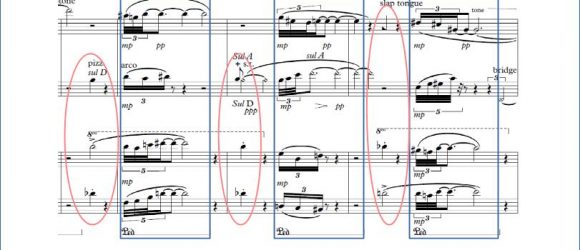Defense of the artistic research project “Structural and Prestructural Compositional Aspects of Sonoristic Music”
- 2016-11-18
- | News

On December 13–14, 2016, the defense of Andrius Maslekovas’ artistic doctorate project “Structural and Prestructural Compositional Aspects of Sonoristic Music” will take place at the Lithuanian Academy of Music and Theatre. Artistic supervisor of the project – Assoc. Prof. Raminta Šerkšnytė, research supervisor – Prof. Dr. Rimantas Janeliauskas, research consultant – Assoc. Prof. Dr. Mārtiņš Viļums. Copies of the research paper and its summary are available at the library of the Lithuanian Academy of Music and Theatre (Gedimino pr. 42).
Free entrance.
Defense of the creative part of the artistic doctorate project
December 13, 2016, 5 p.m.
MUSIC INNOVATION STUDIES CENTRE (Gedimino pr. 42, Vilnius)
CONCERT PROGRAM
Andrius Maslekovas (1985)
Calligraphies of the Last Rays for clarinet, viola and piano (2014)
Incantation of the Freezing Haze for flute solo (2013)
Dissipating Fragrances for violin and accordion (2015)
…she, who is touching blind water shadows… for violin, cello and piano (2012)
Winter Calligraphies for symphony orchestra and mixed choir (2016, world premiere)
Defense of the artistic research paper
December 14, 2016, 11 a.m.
LMTA JUOZAS KAROSAS HALL (Gedimino pr. 42, Vilnius)
CHAIR OF THE DEFENSE BOARD OF ARTISTIC RESEARCH PROJECT – Prof. Vaclovas Augustinas (Lithuanian Academy of Music and Theatre, Music, Composition);
BOARD MEMBERS: Prof. Dr. Rytis Ambrazevičius (LMTA, Humanities, Art Research, Musicology), Prof. Habil. Dr. Gražina Daunoravičienė (LMTA, Humanities, Art Research, Musicology), Assoc. Prof. Rolands Kronlaks (Jāzeps Vītols Latvian Academy of Music, Music, Composition), Prof. Rytis Mažulis (LMTA, Music, Composition);
REVIEWERS: Assoc. Prof. Dr. Ričardas Kabelis (LMTA, Music, Composition), Prof. Dr. Antanas Kučinskas (LMTA, Humanities, Art Research, Musicology).
Abstract
Until the second half of the 20th century manipulation of pitch existed as an indisputable paradigm of musical organisation. However, increased significance of timbre and loudness has infirmed the established hierarchical system of musical parameters, turning the dimension of sound quality into a central element in the construction of a musical piece. Works by such composers as György Ligeti, Krzysztof Penderecki, Witold Lutosławski or Helmut Lachenmann may be regarded as an outburst of said transformations, and along the new aesthetic and constructive ideas that their music contained, it may even be regarded as a paradigmatic turn. The said paradigmatic transformations of compositional construction also prevail in the works by such present-day composers as Mathias Pintscher, Johannes-Maria Staud, Ondřej Adámek, Kaija Saariaho, Harrison Birthwistle, Toshio Hosokawa and others. However, even after nearly six decades since the sound quality has become an aesthetic category and this paradigm has blossomed in a variety of forms and shapes, the methodologies of contemporary music analysis are unable to disclose the essential compositional aspects of this music or the causal dependence behind them. This research paper aims to explain compositional principles of this music and the origins of their emergence. Fields of psychoacoustics and cognitive psychology are employed here. In the light of this knowledge the key aspects of impact of sound parameters on formation of sonoricity is explained, as well as impact of principles of Gestalt perceptual grouping on the communication system that prevails in sonoristic music. The work contains detailed analyses of various communicational levels, that are illustrated in the examples from pieces by Ondřej Adamék, Sofia Gubaidulina, Andrius Maslekovas, Ramūnas Motiekaitis, Mathias Pintscher, Doina Rotaru, Johannes-Maria Staud and many other composers. The last chapter of the thesis is dedicated to the analysis of the oeuvre of Andrius Maslekovas. All structural and prestructural aspects that are discussed throughout this work are being unveiled in detailed analyses of “Calligraphies of the Last Rays” for clarinet, viola and piano (2014) and “Incantation of the Freezing Haze” for flute solo (2013).

